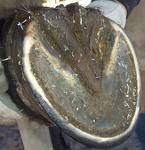 Here is a very informative article by Certified Journeyman II Farrier Keith Seeley.
Here is a very informative article by Certified Journeyman II Farrier Keith Seeley.
Can you identify a good hoof? Do you know what a good hoof looks like? Do you know the difference between a ‘good looking’ foot and a ‘sound’ foot? Is there a difference?
These are some good questions to ponder over, don’t you think? I have come to specialize in lame and / or foundered horses and these days, I see many more unsound and unhealthy feet than I do healthy feet, so many of the horse owners I come into contact with are people who have forgotten what a sound, healthy foot looks like. I hope to be able to explain to you what a so-called good foot is. It’s not easy. There are a number of ways of looking at a foot and not everyone can or will agree on what ‘sound’ or ‘healthy’ looks like. This is a tough topic, but I’ll do my best to explain what we’re looking for or what you’re striving for based on my trim protocol and based on the findings of BOGHS***.
So what does a good foot look like? Well, a good foot will generally be fairly round in shape, not necessarily perfectly round like a circle, but it will generally have a nice rounded or slightly elliptical shape. It will be of sufficient size to carry the animal. It shouldn’t be too large or too small, though larger would be more preferable, depending on the horses’ size, conformation, environment and his purpose or use in life.
The white line will be between 1/8 and 1/4 inch, should have a good uniformed tightness and should be of a nice tan color. There should be no stretching, no chalkiness, and no degradation of any amount. The closer to an 1/8” in thickness, the tighter and stronger the white line is. The white line, or lamina, is responsible for growing hoof wall.
The foot will have a frog that makes good contact with the ground, the frog will have a nice width to it for the size of the foot and it will generally be about two thirds the length of the bottom of the foot from heels to toe. It will have a nice triangular shape, should have a hard, but tough, rubbery feel to it when pressed and shouldn’t look too ‘moth-eaten’ or mottled. Mind you, depending on the time of year, the frog will shed, or molt, about three times a year. The healthier the foot is, the easier it is for the frog to molt and the easier it is to do so all in one piece. But, if it comes off in a few pieces, that’s not a problem. The frog is directly responsible for the health of the bars, for absorbing concussion when the foot strikes the ground, for dissipating energy and converting it to heat, and for pushing blood into the minute recesses of the foot throughout the thousands of micro vessels within the recesses of the foot. Dr. Robert Bowker VMD*, has performed many years or research to determine how the frog works and is directly responsible for each of the afore mentioned issues.
The bars should be nicely formed, reasonably well visible and should make contact with the ground. They shouldn’t stand too upright or lay too far over. According to Dr. Bowker’s research, the optimum angle for the bars is about 60 degrees plus or minus. Their heights will dependent on the environment the horse lives in. If the environment is hard and rocky, it’s likely that the bars will not be too overly noticeable. If the ground is soft, mostly dirt or sand, then the bars will be more pronounced and will be closer to the ground. The bars are another good indicator as to the health of the foot. If they are small, weak or laid over, then the bars aren’t likely to be healthy, which means the frog most likely isn’t healthy. If the bars are large, very noticeable and even has it’s lamina clearly visible, then there’s a good chance that they are healthy and strong. The bars are responsible for growing sole, as well as supporting the coffin bone. This is a fairly new discovery by Tommy Lee Osha** and Dr. Bowker. The inside of the bars make contact with as specific point underneath the coffin bone, which allows the coffin bone to pivot to a small degree inside the foot. If the bars aren’t healthy, then the coffin bone can’t be properly supported, nor can the coffin bone perform its full pivot range…..click here for the rest of the article.
Chris Freeman





